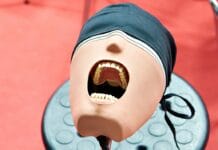It’s here: The time is approaching to move that tassel from right to left. Dental hygiene school has been filled with long clinic days and long nights of studying, but now it is time to start looking for that first job.
While the U.S. Bureau of Labor Statistics cites a shortage of dental health care professionals, getting yourself noticed can still be difficult. Sometimes, all it takes is getting your name to the right people. Other times, it takes presenting a stellar paper or digital version of yourself in order to get the job you want.
Networking
School’s done, and the job hunt is on. So, where is that first step to breaking into a new professional job market? A good first step can be making professional friends beyond those who just turned their tassels along with you. Attending local trade shows/conferences is a great way to meet new people and stay on top of new happenings within the profession. You also get to meet many of the local product representatives who can be great resources for who is hiring in an area, as well as what the culture of a hiring practice is like.
Joining your professional organization is a great way to meet others in the field. Local components often host continuing education seminars, and even if you do not need the CE credits right away, attending events gives you an opportunity to meet others in the field.
Professional organizations such as the ADHA also provide information on volunteering opportunities. Nothing says “give me a job!” like donating time to help others. It shows your skills, work ethic, and dedication to promoting good oral health.
Often, jobs are not advertised but filled solely through networking circles. Building a place for yourself within your professional community makes finding that right-fit job so much easier.
Resumes
While pink resume paper may work for Legally Blonde’s Elle Woods, it is primarily the content on the document itself that makes a potential employer call you in for an interview rather than the color of the paper on which it is printed. That said, make every line count. Avoiding typos and grammatical errors is the most basic step to a good paper presentation of oneself.
Beyond that, the quality and quantity of your content make a big difference. If there’s too little information, you miss the opportunity for your own voice to shine through. Too much, and you risk boring the reader.
Overly modern, styled resumes can appear sparse and give an impression of a lack of effort by the applicant. Instead of sticking to bullet points for everything, short, full sentences can help the reviewer get a better sense of who you are. The more of yourself you can get the reader to identify with, the more comfortable they will feel calling you in for an interview.
Cover Letters
Building on a resume through a cover letter is a great way to pique the interest of a future employer. It should contain the basics of your background in the field and qualifications for the job but in a more conversational form than the resume itself.
Mixed into the story of your work and educational history, there should be some of your personal voice as well. Of course, you want the overall tone to be professional, but make sure it is not dry. Allow some of who you are to shine through in the discussion of your volunteer hours and the latest CE courses attended. Speak about your passions and reasons for being in the field, as this gives the reviewer something to latch onto when going through multiple applications for a single position.
Having a basic cover letter ready is very handy when sending out multiple resumes. You shouldn’t have to edit it much for most job openings before sending it out. However, to ensure you are sending out the most appropriate cover letter, it is always a good idea to do a little research on the dental practice you are applying to – the internet era makes this so simple.
A quick Google search and review of the office’s website can give you a lot of insight as to what type of applicant they are seeking. This information can help you tailor what you focus on in your cover letter.
For example, if you are seeking a job in a public health facility, a cover letter detailing your ability to meet production goals probably is not the right fit. Sending it out that way will not make you seem more hirable to a potential employer because you may appear less in tune with their priorities.
Internet Presence
It is important to be aware that this is the digital age, and just about everyone now has an online presence. We would like to believe that what we do off the clock has little to no bearing on our professional selves, but that is no longer the case.
Employers look up applicants on their social media pages. They scroll through profile pictures and look for anything that could help them decide whether or not to hire someone. It is not possible to retract every unflattering photo or cultivate a social media page to be perfectly professional in every way because personal pages are not supposed to be professional pages, theoretically. However, it is possible to be aware of what is visible to the outside world when applying for jobs.
If maintaining a separation between work and play is necessary, ensure your privacy settings are effective. If you prefer a more open approach to social media, check your page for anything you would see as a red flag if you were an employer looking to hire you. For instance, posts which make you appear irresponsible or unprofessional to a potential employer.
Dental hygiene group pages are a great social media source for hearing about jobs and getting to know about the offices in an area. Most people spend a lot of time online scrolling through posts these days, so make a few of those moments work towards your career by keeping you updated on what those around you are talking about in dental hygiene.
Temping
Spending a day or two in several different offices as a temp employee can flush out your own ideas about what you are looking for in a practice. This will help you be prepared when interviewing if questions come up about what you want.
Temping can also help you build a sense of what you can and can’t live without in practice. Is an operatory with a window a must-have? Do you have a preferred type/brand of instruments? Can you work in an office that only provides two curettes and a single scaler in each cassette?
In addition to equipment familiarity, temping can also help familiarize you with staff. It can serve as a type of working interview where you aren’t formally interviewing and help keep your clinical skills sharp while you search for that perfect job.
Once you’ve cultivated a sensible presence on social media, joined your professional organization, attended some local events, temped in a few offices around town, done some volunteer work, and sent out your flawless resume, then you can sit back and wait for the calls to come in. Whew!
Before you leave, check out the Today’s RDH self-study CE courses. All courses are peer-reviewed and non-sponsored to focus solely on pure education. Click here now.











